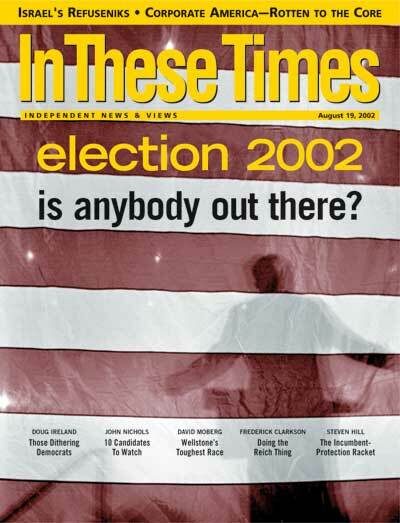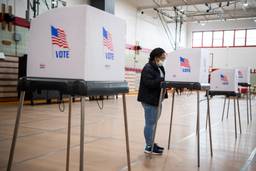Voters, beware. Redistricting, the once-a-decade swindle whereby incumbent politicians redraw the lines of their own legislative districts to guarantee themselves safe seats, is just about completed in all 50 states.
This time around the “incumbent protection” racket was even more crass than usual. The Wall Street Journal reports that out of 435 U.S. House districts, only 11 races are true “toss-ups” that either side could win. Congressional analysts generally have narrowed the field of play to 30 to 40 races. The rest are essentially done deals.
Incumbents took no chances. Consider Rep. Loretta Sanchez, who told the Orange County Register that she and most of her California House colleagues each forked over $20,000 to the political consultant in charge of gerrymandering the district lines. The money was classic “protection money.” “$20,000 is nothing to keep your seat,” Sanchez said. “I spend $2 million [campaigning] every election.”
Voters don’t even need to show up to the polls anymore. And guess what? They won’t. There probably won’t be a single close general election for Congress in such major states as Ohio, Illinois, Michigan, Texas, New Jersey and New York. California has only one race out of 53 considered a toss-up.
One consequence of the lack of competition is that a handful of races will determine which political party wins control of the House. Party leaders and their redistricting consultants have been strategizing over the political map like it’s a military battlefield. And they do it with increasingly powerful computers, mapping software and databases that allow them to slice and dice the electorate in their effort to win control of the legislatures. Then they flood the close races with tons of money, while ignoring those races already locked up. “A lot of money will flow to a relative handful of seats,” says Burdett Loomis, a political scientist at the University of Kansas. “In those seats, it’s nuclear war. Twenty miles away, there’s nothing.”
This year raised “incumbent protection” to a whole new level. The current round of gerrymandering may be the most anti-democratic ever. We like to think of ours as a two-party system, when in fact for most voters it’s a one party system—the party that dominates their district. Demography is destiny, it turns out.
Even more than campaign-finance inequities, this incumbent-protection racket is responsible for creating uninspiring elections where voters have little choice. If you are a Democrat in a solidly Republican district, a Republican in a solidly Democratic district, or a supporter of a minor party, you don’t have a chance of electing your candidate of choice, no matter how much money she spends.
————–
All is not lost. In Arizona, an initiative led by Common Cause and the League of Women Voters took redistricting out of the hands of incumbents and gave it to an independent, nonpartisan commission. In Illinois, citizen groups are leading a “drive to revive” cumulative voting, which would get rid of winner-take-all districts entirely and use three-seat districts that won’t require redistricting. Illinois used such a system from 1870 to 1980 to elect its lower house, and nearly every district had two-party representation. More competition meant more choices for voters, and less control by party machines.
Other efforts for reforms like instant runoff voting (IRV) promise to restore to voters some of the choice they have lost as a result of redistricting shenanigans. With IRV, voters get to indicate their runoff choices at the same time as their first choice by ranking their ballot. San Francisco voters recently voted to elect all local offices using IRV starting next year. In Vermont, voters in 52 towns endorsed an advisory proposal to the state government to use IRV for statewide elections. On August 27, Alaska voters will vote to decide if they want to use IRV to elect most of their state and all of their federal elected officials, including the president.
Our “winner take all” political system now produces the lowest voter turnout in the world among established democracies. Many would-be voters know the system is broken. It’s time that we consider reforms that not only will liberate our democracy from redistricting battles, but empower voters to choose their representatives—and not the other way around.
This time around the “incumbent protection” racket was even more crass than usual. The Wall Street Journal reports that out of 435 U.S. House districts, only 11 races are true “toss-ups” that either side could win. Congressional analysts generally have narrowed the field of play to 30 to 40 races. The rest are essentially done deals.
Incumbents took no chances. Consider Rep. Loretta Sanchez, who told the Orange County Register that she and most of her California House colleagues each forked over $20,000 to the political consultant in charge of gerrymandering the district lines. The money was classic “protection money.” “$20,000 is nothing to keep your seat,” Sanchez said. “I spend $2 million [campaigning] every election.”
Voters don’t even need to show up to the polls anymore. And guess what? They won’t. There probably won’t be a single close general election for Congress in such major states as Ohio, Illinois, Michigan, Texas, New Jersey and New York. California has only one race out of 53 considered a toss-up.
One consequence of the lack of competition is that a handful of races will determine which political party wins control of the House. Party leaders and their redistricting consultants have been strategizing over the political map like it’s a military battlefield. And they do it with increasingly powerful computers, mapping software and databases that allow them to slice and dice the electorate in their effort to win control of the legislatures. Then they flood the close races with tons of money, while ignoring those races already locked up. “A lot of money will flow to a relative handful of seats,” says Burdett Loomis, a political scientist at the University of Kansas. “In those seats, it’s nuclear war. Twenty miles away, there’s nothing.”
This year raised “incumbent protection” to a whole new level. The current round of gerrymandering may be the most anti-democratic ever. We like to think of ours as a two-party system, when in fact for most voters it’s a one party system—the party that dominates their district. Demography is destiny, it turns out.
Even more than campaign-finance inequities, this incumbent-protection racket is responsible for creating uninspiring elections where voters have little choice. If you are a Democrat in a solidly Republican district, a Republican in a solidly Democratic district, or a supporter of a minor party, you don’t have a chance of electing your candidate of choice, no matter how much money she spends.
————–
All is not lost. In Arizona, an initiative led by Common Cause and the League of Women Voters took redistricting out of the hands of incumbents and gave it to an independent, nonpartisan commission. In Illinois, citizen groups are leading a “drive to revive” cumulative voting, which would get rid of winner-take-all districts entirely and use three-seat districts that won’t require redistricting. Illinois used such a system from 1870 to 1980 to elect its lower house, and nearly every district had two-party representation. More competition meant more choices for voters, and less control by party machines.
Other efforts for reforms like instant runoff voting (IRV) promise to restore to voters some of the choice they have lost as a result of redistricting shenanigans. With IRV, voters get to indicate their runoff choices at the same time as their first choice by ranking their ballot. San Francisco voters recently voted to elect all local offices using IRV starting next year. In Vermont, voters in 52 towns endorsed an advisory proposal to the state government to use IRV for statewide elections. On August 27, Alaska voters will vote to decide if they want to use IRV to elect most of their state and all of their federal elected officials, including the president.
Our “winner take all” political system now produces the lowest voter turnout in the world among established democracies. Many would-be voters know the system is broken. It’s time that we consider reforms that not only will liberate our democracy from redistricting battles, but empower voters to choose their representatives—and not the other way around.
Steven Hill is co-founder of FairVote and the author of seven books, including“10 Steps to Repair American Democracy” and “Fixing Elections: The Failure of America’s Winner Take All Politics”. His opinions are his own.








